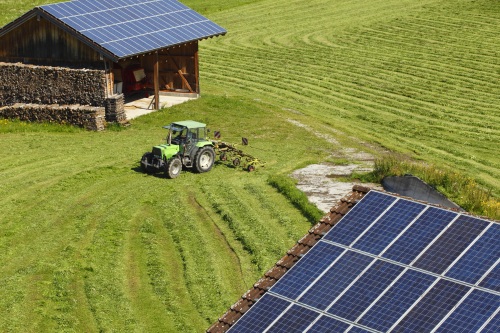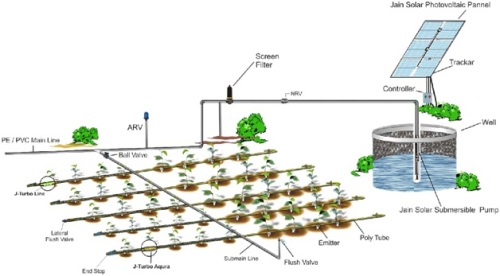|

Farmers have always played a significant role in our society as they provide the world’s population with food. However, one may forget that, not only do they provide food but they also provide energy, which nowadays, is of paramount importance, especially as in light of renewable energies. Indeed, farmers can produce energy from the wind, the sun or the biomass and they can use it for their own farm, or, if they have a surplus, resell it to companies.
Solar energymight be one of the easiest ways for farmers to produce energy. Indeed, farmers usually have several large buildings whose roofs are directly under the sun, without being hindered by the shadows of the trees, turning them into an ideal place to settle a photovoltaic system. Therefore, the use of solar energy in agriculture is becoming increasingly popular and the energy produced from this renewable source can be used either on the farm or in the local power grid, providing the farmer with an additional income.
One of the areas in agriculture that benefits the most from solar energy is irrigation, especially in arid regions. The main reason is that using the sun for irrigation represents a virtuous circle: when the sun shines, it feeds the irrigation system, well, we know that crops needs more water when the sun shines a lot. Therefore, a large quantity of energy is available when it is actually needed.

The pumps used for the transport of the water are equipped with solar cells. The solar energy absorbed by the cells is then converted into electrical energy via a generator which then feeds an electric motor driving the pump. Most of the traditional pump systems mainly work with a diesel engine or with the local power grid. However, these two modes of operations present disadvantages compared to solar pumps.
In many rural areas, especially in developing and emerging countries, the access to the electricity grid is not always guaranteed. In this case, farmers cannot rely on the traditional irrigation system. Thus, using an independent and alternative energy system can be a solution for the farmer to secure a safe power source and for the public grid to avoid saturation.
Diesel pumps are slightly more efficient than AC powered pumps as they allow greater flexibility. However, one of the main constraints is that this system relies on the fuel availability, added to a greater impact on the environment. Diesel-driven pumps are cheaper than solar-powered pumps but the operating costs are quite high and depend heavily on the diesel price. In solar-powered systems, it works the other way round, that is, although this system is relatively expensive, the source of energy is free, therefore, after the amortization period, there are no longer operating costs (only the maintenance costs must be considered). Therefore, solar pumps turn out to be a viable long term investment.
As several studies have shown the access to water for agricultural purposes remains critical in some areas such as in arid regions of Africa and Southern Asia. Many Indian and African farmers fetch the water directly from the well or the rivers and irrigate their fields using buckets. If farmers of those regions could have access to a motorized pump, they would increase their yield by 300%.
Where is solar irrigation happening?

The installation of solar pumps in arid regions such as in Africa, Asia and South America is also part of many development projects, aiming at increasing local farmers productivity and as a consequence, improving their living conditions. One of the successful example of this is the initiative of a Physics teacher in a school in Blankenese (Germany) where students have developed two solar-powered pumping systems in cooperation with the company SET GmbH from Wedel. They installed these systems in two farms in Nicaragua to pump underground water. This project could also be achieved with the collaboration of the UNAN University in León, which deals a lot with the exploitation of solar energy. Indeed, the project has been running for over 10 years and 30 pumps are in operation now in Nicaragua. It is supervised by the Nicaraguan company Enicalsa that helps farmers benefit from solar irrigation. The use of solar pumps allows the latter to produce all year round, even in dry season and thus to increase their income and strengthen their position in the local market.
Aside from the regions previously mentioned, there is also an increasing interest in solar irrigation systems in Europe. Just a few months ago, a mobile solar drip irrigation system from Austria has reached the production stage. The Austrian company Wien Energie carried out this project which pursues a dual objective: on the one hand, reduction of CO2 emissions owing to the use of solar energy, on the other hand, achievement of 30% water savings thanks to the drip irrigation method versus the traditional sprinkler irrigation.
The principle of the drip irrigation method is quite simple. With the use of various valves, hoses and pipes, water drips slowly and at regular intervals to the roots of the plants. Therefore, there is no water waste as water goes directly where it should go, contrary to a sprinkler system in which water evaporates into the air or seeps into soils where no plants grow. Therefore, drip irrigation method enables to grow more crops with less water, turning it into a highly efficient irrigation method.
Therefore, in countries which suffer from high temperatures and scarce water resources, the drip irrigation system could contribute to an efficient water management. This is all the more important as farmers have to face three challenges: save water, money and energy. Mobile solar drip irrigation systems shall turn out to be the perfect answer to face these challenges. Although these systems are still quite expensive and complicated to settle, many R&D projects are working on the democratization of the use of solar power in agriculture, which, in the future (and even now), could play a vital part in the management of the food and energy crisis.
|






